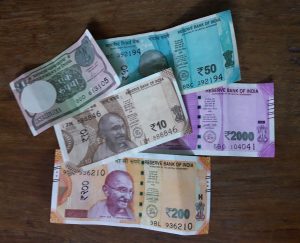The Indian currency is called the Indian Rupee (INR) and the coins are called paise. The rupee is named after rupiya, the silver coin that was first issued by Sultan Sher Shah Suri in the 16th century and continued by the Mughal Empire.
One Rupee consists of 100 paise. The symbol of the Indian Rupee took its present form in 2010, which is ₹ . The design is similar to the Devanagari letter "₹" (ra) and the Latin capital letter "R", with a double horizontal line at the top.
Indian currency is composed of both metallic coins and paper currency notes.
Metallic coins
Coins are being issued in denominations of fifty paise, one rupee, two rupees, five rupees and ten rupees. Coins in the denomination of 1 paise, 2 paise, 3 paise, 5 paise, 10 paise, 20 paise and 25 paise were also issued and circulating but have been withdrawn from circulation with effect from June 30, 2011 . From July 8th coins with new rupee symbol started to be circulated in monetary system of India.
Paper currency notes
One rupee note is issued by Government of India whereas rupee notes of other denominations are issued by Reserve Bank of India. ₹ 10, ₹ 20, ₹ 50, ₹ 100 ₹ 500, and ₹ 1000 notes are currently being issued in India. The printing of notes in the denominations of ₹ 2 and ₹ 5 has been discontinued as there are coins issued by the same denomination but already printed notes are still in circulation.
On 8 November 2016 the Government of India made an announcement making the currency notes of denomination 500 and 1000 with effect from midnight of the same day, invalid and illegal to be used, this move became popular by the term 'Demonetisation' . A redesigned ₹500 banknote, along with a redesigned note of ₹2000 banknote were put into circulation on 10 November 2016. ₹10, ₹50 and ₹200 notes were later introduced in circulation followed by ₹100 note.
Every currency note other than one rupee note bears a promise printed on it. The promise, "I promise to pay the bearer the sum of Rupees …” printed on the note means that the banknote is a legal tender for the specified amount. The obligation on the part of the Reserve Bank of India is to exchange a banknote with bank notes of lower value or other coins which are legal tender under the Indian Coinage Act, 2011, of an equivalent amount.
Currency in India is managed by Reserve Bank of India (RBI). The design, quantity and denominations of currency notes to be printed are decided by the Government of India on the advice of Reserve Bank of India. The quantum of banknotes to be printed, broadly depends on the requirement for meeting the demand for banknotes, GDP growth, replacement of soiled banknotes, reserve stock requirements, etc.
Reserve Bank ensures the quality of notes in circulation. Towards this aim, the banknotes received back from circulation are examined and those fit for circulation are reissued and the soiled and mutilated notes are destroyed .
The role of RBI is limited to distribution of coins that are supplied by Government of India who is responsible for the designing and minting of coins in various denominations.
Currency paper is composed of cotton and cotton rag.
Notes are printed at four printing presses located at Nashik, Dewas, Mysore and Salboni. Coins are minted at the four mints at Mumbai, Noida, Kolkata and Hyderabad.
There are fifteen languages appearing in the language panel of banknotes in addition to Hindi prominently displayed in the centre of the note and English on the reverse of the banknote.

